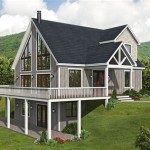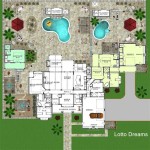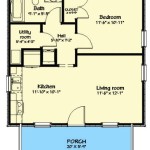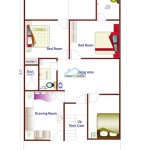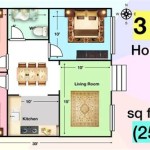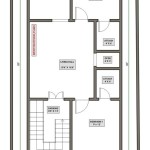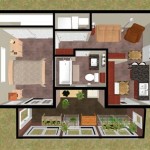Lake Home Plans for Narrow Lots: Maximizing Space and Views
Designing a lake home presents unique opportunities and challenges. The desire to capture stunning waterfront views and embrace outdoor living is paramount, but the available land often dictates the architectural approach. Narrow lots, in particular, require careful planning to optimize space, natural light, and functionality while maintaining aesthetic appeal and structural integrity. This article examines key considerations and design strategies for lake home plans tailored for narrow lots, focusing on maximizing both the indoor living experience and the connection to the surrounding lake environment.
The allure of a lake home stems from the tranquility and recreational opportunities associated with waterfront living. A well-designed lake home should seamlessly integrate with its natural surroundings, offering panoramic views and easy access to the water. For narrow lots, achieving this integration necessitates innovative design solutions that address limitations in width and maximize usable space. The planning process should begin with a thorough assessment of the lot's dimensions, topography, orientation, and local building codes. This initial analysis will inform the design choices and ensure that the final structure complies with all regulations and minimizes environmental impact.
Understanding the Constraints of Narrow Lot Lakefront Properties
Narrow lakefront lots present several inherent design constraints that must be carefully addressed during the planning phase. The limited width restricts the footprint of the house, potentially affecting room sizes and overall layout. Building setbacks, which are regulations that dictate the minimum distance a structure must be from property lines and the waterfront, further constrain the buildable area. These setbacks are crucial for preventing encroachment on neighboring properties and protecting the integrity of the shoreline. It is essential to obtain accurate survey data and consult with local zoning officials to determine applicable setback requirements before commencing the design process.
Furthermore, narrow lots often present challenges related to privacy. Proximity to neighboring properties can necessitate design solutions that minimize overlooking and create a sense of seclusion. Strategic placement of windows, landscaping, and outdoor living spaces can help to mitigate these privacy concerns. Additionally, the elongated shape of a narrow lot can impact the flow of natural light throughout the house. Careful consideration must be given to the orientation of the building and the placement of windows and skylights to ensure adequate illumination and minimize the need for artificial lighting.
Another crucial factor to consider is the topography of the lot. Many lakefront properties feature sloping terrain, which can pose challenges for construction and foundation design. Steep slopes may require extensive excavation and retaining walls, which can increase construction costs. However, a well-integrated design can leverage the natural topography to create unique architectural features and enhance the views from the house. Working with a qualified architect and engineer is essential to develop a design that addresses the specific challenges posed by the lot's topography.
Design Strategies for Optimizing Space in Narrow Lake Home Plans
Several design strategies can effectively maximize space and functionality in lake home plans designed for narrow lots. Vertical construction is often the most effective way to compensate for limited lot width. Building upwards, rather than outwards, allows for the creation of multiple levels with ample living space. Multi-story designs can also provide better views of the lake, as higher vantage points offer unobstructed panoramas. However, careful consideration must be given to the accessibility of upper floors, particularly for individuals with mobility limitations. Incorporating an elevator or strategically placed staircases can enhance the long-term usability of a multi-story lake home.
Open floor plans are another effective way to create a sense of spaciousness in a narrow lake home. By eliminating walls between living areas, such as the kitchen, dining room, and living room, a more expansive and airy atmosphere can be achieved. Open layouts also facilitate better flow of natural light and ventilation throughout the house. To define different zones within the open space, architectural elements such as changes in flooring, ceiling heights, or strategically placed columns can be used.
Integrating indoor and outdoor living spaces is critical for maximizing enjoyment of a lake home. Decks, patios, and screened porches can extend the living area and provide opportunities for outdoor dining, relaxation, and entertainment. On narrow lots, these outdoor spaces can be designed to cantilever over the water, creating a sense of being immersed in the lake environment. Large windows and sliding glass doors can further blur the lines between indoors and outdoors, allowing natural light and fresh air to permeate the house.
Clever storage solutions are essential for maintaining a clutter-free and organized living space in a narrow lake home. Built-in shelving, cabinets, and drawers can maximize storage capacity without sacrificing valuable floor space. Utilizing vertical space for storage is particularly effective in narrow environments. Consider incorporating shelving units that extend to the ceiling or installing overhead cabinets in the kitchen and bathrooms. Under-stair storage and hidden compartments can also provide additional storage options.
Attention to detail in the selection of materials and finishes can also contribute to the overall sense of spaciousness. Light colors and reflective surfaces can help to brighten the interior and make it feel larger. Utilizing mirrors strategically can create the illusion of more space. Minimalist décor and furniture can also help to prevent the space from feeling cluttered. Opting for furniture with clean lines and simple designs can create a more streamlined and uncluttered look.
Key Architectural Elements for Narrow Lot Lake Homes
Specific architectural elements can enhance the aesthetics and functionality of a lake home designed for a narrow lot. Large windows and expansive glass doors are essential for maximizing views of the lake and allowing natural light to flood the interior. Consider incorporating floor-to-ceiling windows or panoramic sliding glass doors to create a seamless connection between the indoor and outdoor spaces. The placement of windows should be carefully considered to optimize views and minimize glare. Tinted or low-E glass can help to reduce heat gain and protect interior furnishings from fading.
Balconies and decks can provide valuable outdoor living space and enhance the architectural appeal of the house. Cantilevered balconies can extend over the water, creating a dramatic visual effect and offering unobstructed views of the lake. Decks can be designed to wrap around the house, providing multiple access points to the outdoors. Incorporating railings made of glass or cable can minimize visual obstruction and maximize the views from the deck.
Strategic use of rooflines can also enhance the aesthetics and functionality of a lake home. Gable roofs can add visual interest and create more headroom on the upper floors. Shed roofs can be used to create covered outdoor spaces or to direct rainwater away from the house. Dormers can be incorporated to add natural light and ventilation to attic spaces. The roof design should be carefully considered to complement the overall architectural style of the house and the surrounding landscape.
The exterior materials selected for a lake home should be durable, weather-resistant, and aesthetically pleasing. Natural materials such as wood, stone, and brick can blend seamlessly with the surrounding landscape. Siding materials such as cedar shingles or clapboard can add visual appeal and provide protection from the elements. The color palette should be chosen to complement the natural environment. Earth tones and muted colors can create a harmonious and inviting atmosphere.
Landscaping plays a vital role in enhancing the beauty and privacy of a lake home. Native plants and trees can be used to create a natural and sustainable landscape. Trees can provide shade and privacy, while shrubs and flowers can add color and texture. The landscaping should be designed to minimize erosion and protect the shoreline. Retaining walls and terraced gardens can be used to stabilize slopes and create level outdoor spaces.
In summary, designing lake home plans for narrow lots requires a thoughtful and creative approach. Careful consideration of the lot's constraints, innovative space-saving strategies, and strategic architectural elements are essential for creating a functional, aesthetically pleasing, and environmentally responsible lake home. By working with a qualified architect, engineer, and contractor, it is possible to transform a challenging narrow lot into a dream lake home that maximizes enjoyment of the waterfront environment.

Luxe Lake House Plans From Visbeen Architects Houseplans Blog Com

Narrow Lot Lake House An Ideabook By Bcfry

Small Cosy Homes Narrow Lot House Plans Mediterranean Style Lake

Narrow Lot House Plans And Designs Sater Design Collection

Lake House On Long Narrow Lot Google Search Designs Exterior Mountain

Aaron S Beach House Coastal Plans From Home

Simple Narrow Lot House Plans Houseplans Blog Com

House Plan Of The Week Narrow Lot Beach Home Designers

Narrow Lot House Plan For Lake Lots Max Fulbright Designs

House Plans For Narrow Lots On Waterfront Lake Small Houses Lot

